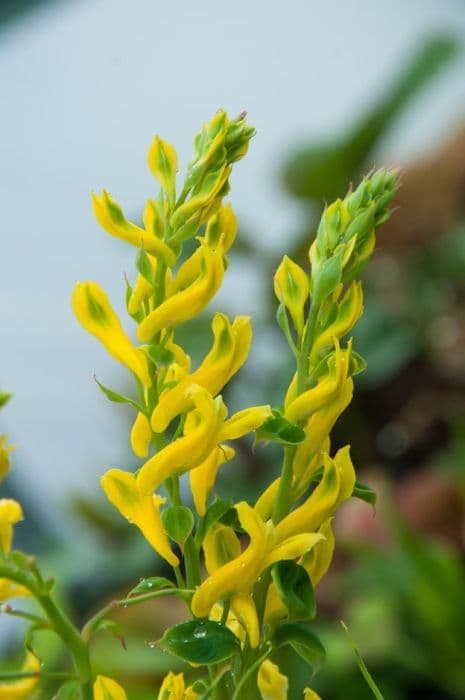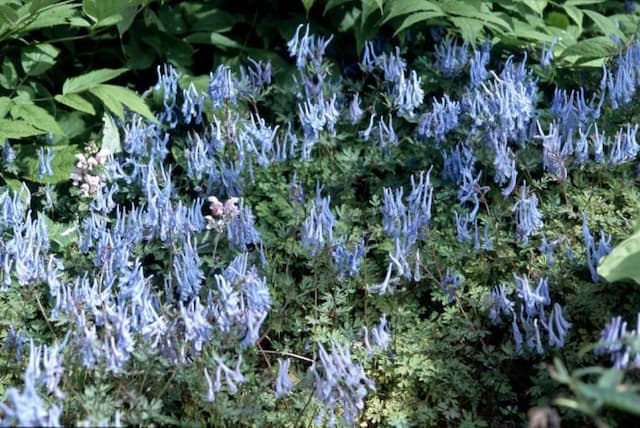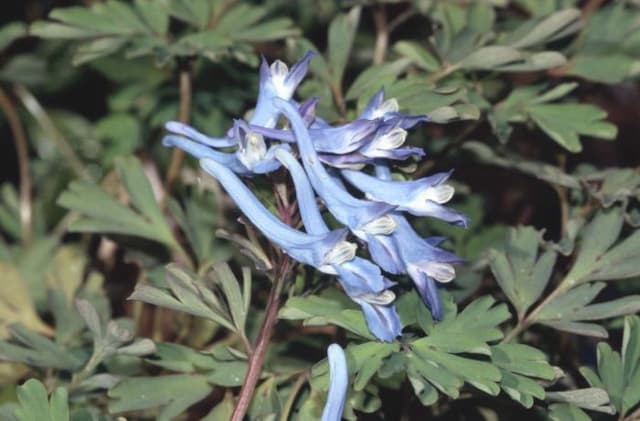Bleeding Heart Dicentra formosa 'Bacchanal'

ABOUT
The plant Dicentra formosa 'Bacchanal', commonly known as western bleeding heart 'Bacchanal', bears a distinctive appearance. It is characterized by its elegant, arching stems from which dangle heart-shaped flowers. The flowers are of a deep red color, resembling small hearts with a droplet at the bottom, giving them a bleeding heart appearance. Adding to the dramatic display, the delicate flowers are arranged in a row along the stem, creating an enchanting effect as if they are floating. The foliage of the western bleeding heart 'Bacchanal' is equally attractively, with fern-like leaves that are finely dissected, imbuing the plant with a soft, lacy texture. These leaves are a blue-green shade, providing a beautiful contrast against the richness of the red flowers. The leaves typically form clumps, which gracefully supports and showcases the flowering stems. This variety is prized for its vivid bloom color and the striking visual contrast it affords against its foliage. Without doubt, the western bleeding heart 'Bacchanal' is a stunning plant that adds a touch of romantic drama and vibrant color to any garden setting in which it is placed.
About this plant
 Names
NamesSynonyms
Western Bleeding Heart, Pacific Bleeding Heart.
Common names
Dicentra formosa 'Bacchanal'.
 Toxicity
ToxicityTo humans
Bleeding heart is considered toxic due to the presence of isoquinoline alkaloids. Ingesting any part of the plant can lead to symptoms such as vomiting, diarrhea, dizziness, and confusion. Ingestion of large quantities can be particularly dangerous, potentially causing convulsions and heart problems. It is generally advised to avoid ingesting this plant and to handle it with care to avoid skin irritation.
To pets
Bleeding heart is also toxic to pets, including cats and dogs, due to isoquinoline alkaloids. Ingesting parts of the plant can cause symptoms such as drooling, nausea, vomiting, diarrhea, tremors, and in severe cases, seizures or cardiac issues. It is important to prevent pets from having access to this plant to avoid potential poisoning.
 Characteristics
CharacteristicsLife cycle
Perennials
Foliage type
Deciduous
Color of leaves
Green
Flower color
Red
Height
1-2 feet (30-60 cm)
Spread
1-2 feet (30-60 cm)
Plant type
Herb
Hardiness zones
3-9
Native area
North America
Benefits
 General Benefits
General Benefits- Attracts pollinators: Dicentra formosa 'Bacchanal' is known for attracting bees and butterflies, supporting local ecosystems.
- Aesthetic appeal: With its striking deep red flowers and fine foliage, it adds beauty to any garden setting.
- Shade tolerance: As a woodland plant, it thrives in shaded areas where other plants may struggle to grow.
- Low maintenance: It is relatively easy to care for, requiring minimal maintenance once established.
- Drought resistance: Once established, it can tolerate periods of drought, making it suitable for drier climates or water-wise gardens.
- Deer resistance: It is generally resistant to deer, which can be beneficial in areas where deer predation is a problem.
 Medical Properties
Medical Properties- This plant is not used for medical purposes.
 Air-purifying Qualities
Air-purifying QualitiesThis plant is not specifically known for air purifying qualities.
 Other Uses
Other Uses- Pressing and Framing - Bleeding heart 'Bacchanal' flowers can be pressed and framed as a unique piece of botanical art, showcasing their intricate shapes and deep colors.
- Educational Tool - These plants can be used in educational settings to demonstrate plant biology and pollination as they have distinct heart-shaped flowers that intrigue learners.
- Photography - Bleeding hearts provide a stunning photographic subject for photographers, especially macro photography, due to their unique appearance and vibrant color.
- Symbolic Gifts - Their heart-shaped flowers can make them a meaningful gift for loved ones, symbolizing love and affection.
- Creative Crafts - The flowers and foliage can be used in crafting, such as in making bookmarks, greeting cards, or for decoupage projects.
- Wedding Decor - Their dramatic flowers can be incorporated into wedding decorations or bridal bouquets as a symbol of true love.
- Garden Themes - Bleeding heart can be used in garden designs that aim to create a romantic or whimsical atmosphere.
- Mood Modulation - Positioning this plant within a living or working space can enhance the environment's ambience and provide a calming visual focus.
- Bee Garden Addition - Bleeding heart is attractive to bees and can be a useful addition to gardens designed to support pollinators.
- Living Mulch - When planted densely, the foliage can act as a living mulch, helping to retain soil moisture and suppress weeds.
Interesting Facts
 Feng Shui
Feng ShuiThe Bleeding Heart is not used in Feng Shui practice.
 Zodiac Sign Compitability
Zodiac Sign CompitabilityThe Bleeding Heart is not used in astrology practice.
 Plant Symbolism
Plant Symbolism- Love: The common name for Dicentra formosa 'Bacchanal' is Pacific bleeding heart, and bleeding hearts in general are known to symbolize love and romance, with their heart-shaped flowers often associated with expressions of deep emotions and passion.
- Compassion and Empathy: The unique shape of the flower, resembling a heart with a droplet beneath it, is evocative of a compassionate and empathetic heart that can feel and share the pains of others.
- Rejection in Love: Pacific bleeding heart can also symbolize rejection or unrequited love, owing to the 'bleeding' aspect which can be associated with the pain of love not reciprocated.
 Water
WaterThe Pacific Bleeding Heart should be watered thoroughly, with the top inch of soil allowed to dry out between watering sessions. It usually requires watering every week, but this can vary with local conditions such as temperature and humidity. A deep watering that provides about one to two gallons of water to the root zone is ideal, ensuring moisture reaches the plant's deep roots. In the warmer months, you may need to water more frequently, especially if the plant is in a sunnier location or if it's particularly hot. Cut back on watering in the winter months when the plant is not actively growing.
 Light
LightThe Pacific Bleeding Heart thrives in partial shade to full shade conditions. It's best planted in a spot that is sheltered from intense afternoon sun, which can scorch its delicate foliage. Morning light with dappled sun or shade throughout the day is ideal for this plant. Avoid deep, dark shade as this can lead to poor flowering.
 Temperature
TemperatureThe Pacific Bleeding Heart prefers moderate temperatures and will grow best when daytime temperatures are between 55 and 75 degrees Fahrenheit. Nighttime temperatures should not drop below 30 degrees Fahrenheit to avoid damage to the plant. It is hardy to USDA zones 3 to 9, indicating an ability to survive in minimum temperatures ranging from 30 to 40 degrees Fahrenheit, although it will go dormant in the winter.
 Pruning
PruningPruning the Pacific Bleeding Heart should be done to remove dead or damaged foliage and to maintain plant health. It is best to prune after the plant has finished flowering, usually in late summer or fall. Cut back the foliage to the ground level; this helps to prevent disease and prepares the plant for its dormant period. Pruning annually or as needed will also promote vigorous growth and better flowering in the following season.
 Cleaning
CleaningAs needed
 Soil
SoilFor Western Bleeding Heart, the best soil mix is well-draining, rich in organic matter, and slightly acidic to neutral (pH 6.0-7.0). A mix of loam, peat or leaf mold, and perlite or coarse sand is ideal.
 Repotting
RepottingWestern Bleeding Heart rarely needs repotting and prefers to be left undisturbed. If necessary, repot in spring every 3-4 years or when it outgrows its container.
 Humidity & Misting
Humidity & MistingWestern Bleeding Heart thrives in average to high humidity levels, aiming for around 40-50% relative humidity for optimal growth and flower development.
 Suitable locations
Suitable locationsIndoor
Place in bright, indirect light and keep soil moist.
Outdoor
Plant in part-shade, moist well-draining soil.
Hardiness zone
4-9 USDA
 Life cycle
Life cycleThe life of Dicentra formosa 'Bacchanal', commonly known as the 'Bacchanal' Pacific bleeding heart, begins with seed germination, which typically occurs in cool, moist soil conditions of its native woodland habitat. Once germinated, the plant develops a rosette of fern-like foliage, which is then followed by the emergence of arching stems bearing heart-shaped flowers in shades of deep red or burgundy in the spring to early summer. After flowering, the plant sets seed in the form of a capsule which, when mature, disperses seeds that may lie dormant until the following spring. During the summer, the 'Bacchanal' Pacific bleeding heart may enter a period of dormancy, especially in hotter climates, with the foliage dying back until cooler conditions prevail. The plant will remain dormant through the winter months, storing energy in its underground structures such as rhizomes or tubers. With the return of spring, the cycle begins anew with fresh foliage growth, leading up to another flowering season.
 Propogation
PropogationPropogation time
Spring-early summer
Propogation: The Dicentra formosa 'Bacchanal', commonly known as the Pacific Bleeding Heart, is typically propagated by division, which is best done in the early spring or fall. To propagate by division, carefully lift the plant from the ground with a shovel or garden fork, ensuring a generous amount of soil is kept around the roots. Once lifted, use your hands or a sharp knife to divide the root ball into smaller sections, each with several shoots and a portion of the root system. These divisions can then be replanted in the garden at the same soil depth they were originally growing, spacing them about 12 inches (approximately 30 centimeters) apart to allow room for growth. Water the newly planted divisions thoroughly to help establish them in their new locations.









